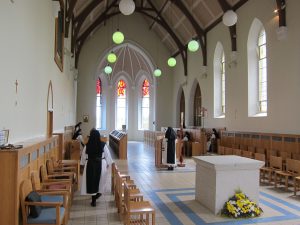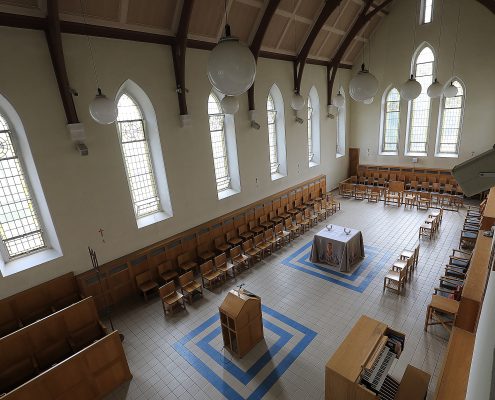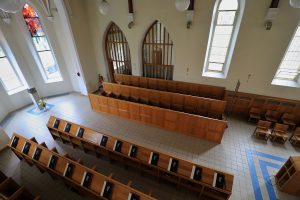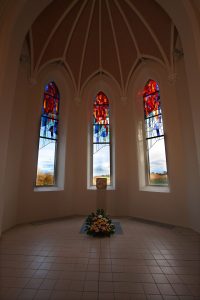Church: the People of God, Body of Christ, Temple of the Holy Spirit

The Abbey church is the place where we assemble seven times a day to pray together, to sing God’s praise, to listen to the Word of God, to celebrate our faith, and to be fed at the table of the Lord.
The interior of the church was reordered in 1990 to bring it into line with contemporary liturgical norms and the needs of the community. The word ‘Church’ means ‘convocation’ or ‘assembly’. The Church is the assembly of those whom God’s word gathers together to form the People of God. Nourished by the Eucharist, this people becomes the Body of Christ. The Holy Spirit is the source of the Church’s life, unity, and gifts, and makes the Church the temple of the living God.
The term ‘Church’ applies, therefore, first of all to the people, the assembly of believers, who are the ‘living stones’ in the Temple of God. The building where this people gathers for worship is also called ‘church’, a place which signifies and makes visible the Church living in this place.
The Eucharist
 The altar, around which we gather, is the focal point in the area of the church where we assemble for the Eucharist. To this altar we bring our gifts of bread and wine, symbolising ourselves and all we are. On this altar the gifts are offered to God in remembrance of the saving death and resurrection of Jesus, and the sacrifice of the cross is made present under sacramental signs. From this altar, the table of the Lord, we are fed with the Body and Blood of Christ as our saving food.
The altar, around which we gather, is the focal point in the area of the church where we assemble for the Eucharist. To this altar we bring our gifts of bread and wine, symbolising ourselves and all we are. On this altar the gifts are offered to God in remembrance of the saving death and resurrection of Jesus, and the sacrifice of the cross is made present under sacramental signs. From this altar, the table of the Lord, we are fed with the Body and Blood of Christ as our saving food.
The ambo is the place from which the Word of God is proclaimed. In the readings, explained by the homily, God speaks to us, nourishing our spirit, and Christ is present in his word. We respond to this word through the psalm, we greet the Gospel with the Alleluia acclamation, and express our adherence to it in the Creed. Moved by this word, we pray in the general intercessions for the needs of the Church and the world.
The president’s chair, used by the priest when he is not at the altar or the ambo, is designed to indicate that he is both a member of the family gathered around the altar and one who plays a special role within that family as the head of the liturgical assembly.
The Liturgy of the Hours
 Seven times a day the monastic community assembles to celebrate the liturgy of the hours, prayers of praise and supplication. The sisters assemble in the stalls, which are designed in traditional style with two ‘choirs’ facing one another.
Seven times a day the monastic community assembles to celebrate the liturgy of the hours, prayers of praise and supplication. The sisters assemble in the stalls, which are designed in traditional style with two ‘choirs’ facing one another.
The readings are proclaimed from the same ambo as is used for Mass.
The Reservation of the Blessed Sacrament
The tabernacle where the Body of Christ is reserved after Mass stands at the east end of the church. The primary reason for such reservation in churches is so that the food of the Eucharist can be brought to those unable to participate in the liturgy, especially the sick and dying. Christ’s presence in this sacramental form is also the focus for individual’s prayer and adoration outside the Mass.
The blue tiles around the altar and the ambo and tabernacle indicate that these are holy areas where something particularly special happens.
Other Features of St Mary’s Abbey Church
The icon depicts the Virgin Mary under her primary and greatest title: Mother of God. Intimately bound to her Son, her cheek gently touches his in a gesture of tender care. She extends that same care to us, the sisters and brothers of her Son, on our earthly journey.
The windows in the apse, with their abstract stained-glass design, provide a feature of great beauty and light in the church, while the clear glass and view of the countryside outside connects us not only with the beauty of nature but with the world and all its people while we pray.
The twelve crosses on the walls indicate that this church has been dedicated, blessed and set aside for the worship of God (they are not Stations of the Cross). On August 27th, the anniversary of the dedication of the church, candles are lit at these crosses, and we keep a feast, celebrating this beautiful church, but above all celebrating the fact that we, the community, are the people of god, the Church, the place where God lives.
 Artists who have contributed to Our re-ordered Abbey church:
Artists who have contributed to Our re-ordered Abbey church:
Architect: Richard Hurley
Altar carved by: Tom Glendon
Furniture in wood: Eric Pearse
Psalter design & calligraphy: Margaret Daly-Denton
Stained glass windows in apse: Phyllis Burke
Tabernacle and crucifix: Br. Benedict Tutty OSB
Icon: Sr Paula Kiersey OCSO
‘In her earthly state, the Church needs places where the community can gather together. Our visible churches, holy places, are images of the holy city, the heavenly Jerusalem, towards which we are making our way on pilgrimage.’
Catechism of the Catholic Church: On the Place where Liturgy is Celebrated
